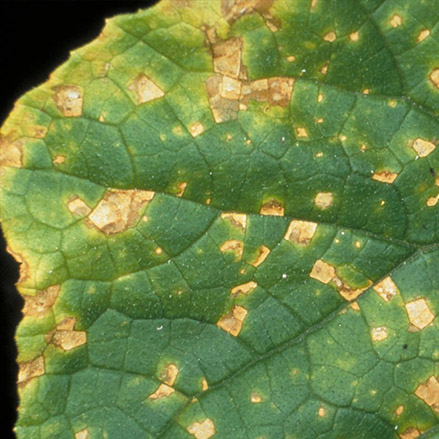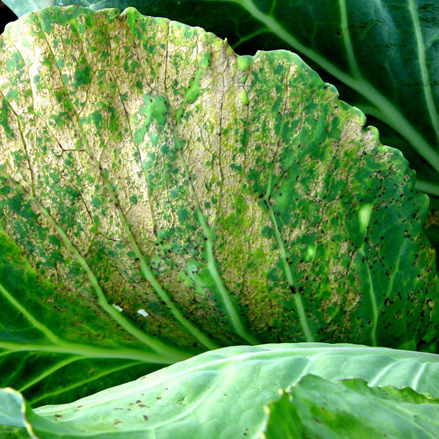GARDEN PESTS & DISEASES A-E
Grosafe Garden has a wide range of pesticides to assist in controlling many common pests and diseases found in New Zealand gardens. Our range (apart from Buxus Blight Fighter and GroVentive® Garden) is certified for organic input No.4547.
Please check our series of Spray Calendars for helpful information on the optimum times to apply treatment.

Anthracnose
A fungal disease that affects many plants, including vegetables, fruits, and trees. It causes dark, sunken lesions on leaves, stems, flowers, and fruits. It also attacks developing shoots and expanding leaves. It can spread very quickly during rainy seasons. Anthracnose generally appears first as small, irregular yellow or brown spots. These spots darken as they age and may also expand, covering the leaves. On vegetables, it can affect any part of the plant. On fruits, it produces small, dark, sunken spots, which may spread. In moist weather, pinkish spore masses form in the center of these spots. Eventually, the fruits will rot.
Treat with FreeFlo Copper

Angular Leaf Spot
Angular leaf spot is a bacterial disease commonly found in cucumbers, as well as squash, pumpkins, melons, and other cucurbits. Caused by the bacterium Pseudomonas syringae, the disease produces lesions on the leaves and fruit of infected plants. While the lesions on fruit are usually minor, they often enable secondary fungal and bacterial infections which rot the fruit.
Treat with FreeFlo Copper

Aphids
Small sap sucking insects that often congregate on new plant growth, buds and under leaves. They excrete a sticky substance as they feed which can attract other insect pests and cause further diseases such as Sooty Mould.
Treat with GroVentive® Garden and/or EnSpray 99® Spraying Oil, BioNeem®

Bacterial Blast
Stone fruit trees are the most susceptible to this disease, but the disease can also spread to other trees through open wounds or via the use of a pair of dirty secateurs. Bacterial blast is a disease that presents by creating open oozing ‘cankers’ on branches or trunks of trees. This causes sudden decay of flower buds and dieback on branches and, in major cases, the entire tree. This disease will grow in periods of damp and wet conditions with low temperatures ceasing when temperatures rise.
Treat with FreeFlo Copper

Bacterial Blight
Bacterial blight affects a wide range of plants. Small, dark green, water-soaked lesions appear on leaves. The lesions may enlarge and accumulate but are limited by leaf veins, so they develop into a characteristic fan shape. Under high humidity, bacterial ooze may be visible in the lesions. As they age, the blotches turn yellow and later become dry, brown and papery. Blight is most severe in wet and windy conditions. Remove and destroy affected plant material and do not save seed from diseased pods. The disease can easily spread through natural openings, so check plants regularly,
Treat with FreeFlo Copper

Bacterial Speck
Bacterial speck is similar to bacterial spot and bacterial canker, but is easy to distinguish based on the symptoms. The disease is caused by the bacteria Pseudomonas syringae pv. The symptoms are small slightly raised spots that appear on the leaves and fruit of the tomato plant, which are distinctly smaller than the spots that occur with bacterial spot and bacterial canker. The lesions start off as small black spots, most often surrounded by a yellow or golden ring, infected leaves will also curl up on the edges and tip.
Treat with FreeFlo Copper

Bacterial Spot
Symptoms of bacterial spot first appear as small, greasy, and irregular marks under the tomato plant’s leaves. Fruit lesions are small dark brown bumps that sink into the fruit as it grows, making it appear scabbed.
Treat with FreeFlo Copper

Black Spot
Black spot fungal leaf disease shows itself first with black spots appearing on the leaf, then with rings of yellow as the spots grow, until the leaf turns entirely yellow and then falls off. If left untreated, black spot spreads rapidly and weakens plants severely.
Treat with FreeFlo Copper

Bladder Plum
Bladder plum is a fungus disease similar to peach leaf curl. It over-winters in leaf and flower buds. When favourable conditions are prevalent, such as cool wet weather in spring, the fungus multiplies. It is spread by rain splash. The young fruits become yellow-green and are bigger than the healthy ones. After onset, the fruits are deformed, and the shell of the stone is destroyed. On the surface of the fruits appears a grey fluff, that represents the fructifications of the fungus. After 3-4 weeks the fruits wrinkle and fall massively. The fungus winters as a mycelium on the bark of the trees.
Treat with FreeFlo Copper

Botryosphaeria
Botryosphaeria canker is a common fungal disease of trees and woody shrubs, but it only attacks plants that are already stressed or weakened by other pathogens. Cankering can become quite extensive within the cambian layers, heartwood and inner bark of woody plants, cutting off the tissues that transport water and nutrients throughout the plant. Botryosphaeria fungi may initially colonize dead branch tissue and move downward on the branch into healthy bark and sapwood. Spread of these fungi occurs through air movement or splash dispersal of spores, and can also occur through use of contaminated pruning tools.
Treat with FreeFlo Copper

Botrytis
Botrytis first appears as a white growth but very soon darkens to a gray color. “Dusty” spores form and are spread by the wind or in water. Moisture is one of the main causes of gray mould. The wetter your plants are, the more susceptible they are to becoming infected. Your plants also must be injured before they can become infected.
Treat with EnSpray 99® Insect Oil

Brown Rot
Brown rot is a fungal disease that can devastate stone crop fruits such as nectarines, peaches, cherries and plums. The first symptoms of the disease are often seen in spring with dying blossoms that form a grayish fuzzy spore mass on the branch. When maturing fruit is infected, the signs begin with a small brown rotted spot and rapid spore growth.
Treat with FreeFlo Copper

Buxus Blight
A fungal disease that affects Buxus species. The disease causes leaves to brown and fall off, causing bare patches. It can also infect young stems and cause black streaks and dieback. In damp conditions the spore masses may be visible on the lower side of infected leaves.
Treat with Buxus Blight Fighter

Cane Spot
The canes (stems) of the bushes infected with Cane Spot have clearly defined dark marks on them with a purple border. These normally first appear on the lower parts of the canes, and gradually work their way upwards. Regular clearing of debris at the base of the plant will prevent it’s spread. In addition, ensure that all canes which have produced fruit are removed as soon as possible. If the disease does take hold, the young shoots will shrivel. In these cases, the treatment is to spray with a copper fungicide and cut out the worst affected canes. Cane Spot is a fungus which over-winters on the canes, springing back into life late Spring to early summer.
Treat with FreeFlo Copper

Cane Wilt
Cane blight is a fungal disease that begins in primocane wound sites. A wound may begin after tip pruning or if the primocanes rub against a trellis wire or each other. This fungal infection causes cankers to form on the cane, sometimes encircling it. Early in the infection, the cankers are reddish-brown under the bark. The cankers can cause leaves in the infected area to wilt then die. An entire cane may wilt and die if the cankers encircle it.
Treat with FreeFlo Copper

Dieback
A disease of trees and shrubs characterized by death of the young shoots, which spreads to the larger branches: caused by injury to the roots or attack by bacteria or fungi. Fungi often associated with cankers and dieback include Botryosphaeria, Nectria and Phomopsis. Symptoms caused by canker and dieback fungi include wilting, yellowing, and browning of leaves, defoliation, dark and sunken areas (cankers) on stems and branches, loose bark, browning of wood within dying branches, and branch dieback.
Treat with Buxus Blight Fighter

Downy Mildew
Downy mildew (often confused with powdery mildew) is a plant disease caused by a spore that spreads from plant to plant via water. Symptoms include dark patches on top of the leaves, often with corresponding furry or downy growth on the undersides. Downy mildew occurs in humid conditions and affects vegetables, fruits and ornamental shrubs and flowers.
Treat with FreeFlo Copper or Buxus Blight Fighter

Early Blight
Common on tomato and potato plants, early blight is caused by the fungus Alternaria solani . Symptoms first appear on the lower, older leaves as small brown spots with concentric rings that form a “bull’s eye” pattern. As the disease matures, it spreads outward on the leaf surface causing it to turn yellow, wither and die. Eventually the stem, fruit and upper portion of the plant will become infected. Early blight overwinters on infected plant tissue and is spread by splashing rain, irrigation, insects and garden tools. In spite of its name, early blight can occur any time throughout the growing season. High temperatures and wet, humid conditions promote its rapid spread. In many cases, poorly nourished or stressed plants are attacked.
Treat with FreeFlo Copper

European Canker
European canker is a debilitating fungal disease of apple trees especially in wetter areas of New Zealand. The spores are immediately infectious if they land on fresh wound tissue. They are spread by rain splash. Lesions develop from these infections and spread concentrically eventually girdling branches. Spores from new cankers are spread primarily by rain or overhead irrigation. New infections are thought to occur mainly in the autumn through leaf scars, with symptoms appearing the following spring. Older cankers produce airborne spores (ascospores) that can initiate new infections at a distance from the source. Prune out diseased wood.
Treat with InocBloc Organic Pruning’n’Paste
